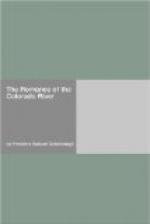Going on southward past what is now Parowan, they came to the headwaters of a branch of the Virgen, in Cedar Valley, and this they followed down to the main stream which they left flowing south-westerly. The place where they turned from it was probably about at Toquerville.* They were now trying to make their general course south-east. Could I but see the original I certainly could identify the route from here on, having been over the region so often. As Escalante was obtaining what information he could from the natives, it seems to me that his first course “south-east” was to Pipe Spring along the foot of the Vermilion Cliffs, then his “north-east” was up toward Kanab and through Nine-Mile Valley to the head of the Kaibab, where a trail led him over to House Rock Valley, on his “south-east” tack, skirting the Vermilion Cliffs again. But they lost it and struck the river at Marble Canyon, through a misunderstanding of the course of the trail, which bore easterly and then northerly around the base of the cliffs to what is now Lee’s Ferry, where there was an ancient crossing. Another trail goes (or did go) across the north end of the Paria Plateau and divides, one branch coming down the high cliffs about three miles up the Paria from the mouth, by a dizzy and zig-zag path, and the other keeping on to the south-east and striking the river at the very point for which Escalante was evidently now searching. Perhaps the Pai Utes had told him of this trail as well as the one he tried to follow, which would have taken him to the Lee’s Ferry crossing about thirty-five miles below. He seems to have reached the brink of Marble Canyon, perhaps half-way between the Paria and the Little Colorado,** and followed up-stream first north and then (beyond Paria) north-east, hunting for a ford. Twice he succeeded in descending to the water, but both times was unable to cross. They had now become so reduced in food that they were obliged to eat some of their horses. With great difficulty they climbed over the cliffs, and at the end of twelve days from their first arrival at the river they found the ford, which ever since has been called El Vado de los Padres. This was the 8th of November, 1776. The entrance to the river from the west, the side of their approach, is through a small canyon in the homogeneous sandstone, no more than ten feet wide. The course is then about half a mile down the middle of the river over a long bar or shoal to the opposite side, where the exit is made upon a rocky slope. It is a most difficult ford. The trail through the water at the low stage, when, only, fording is possible, is marked by piles of large stones. There is no ford at the Lee’s Ferry crossing.
* From here to the California mission of San Gabriel would hardly have been as difficult as the route taken, excepting perhaps the matter of water, and little if any further than the distance to Santa Fe, but the Pai Utes could give him no information of the distance to the sea.




